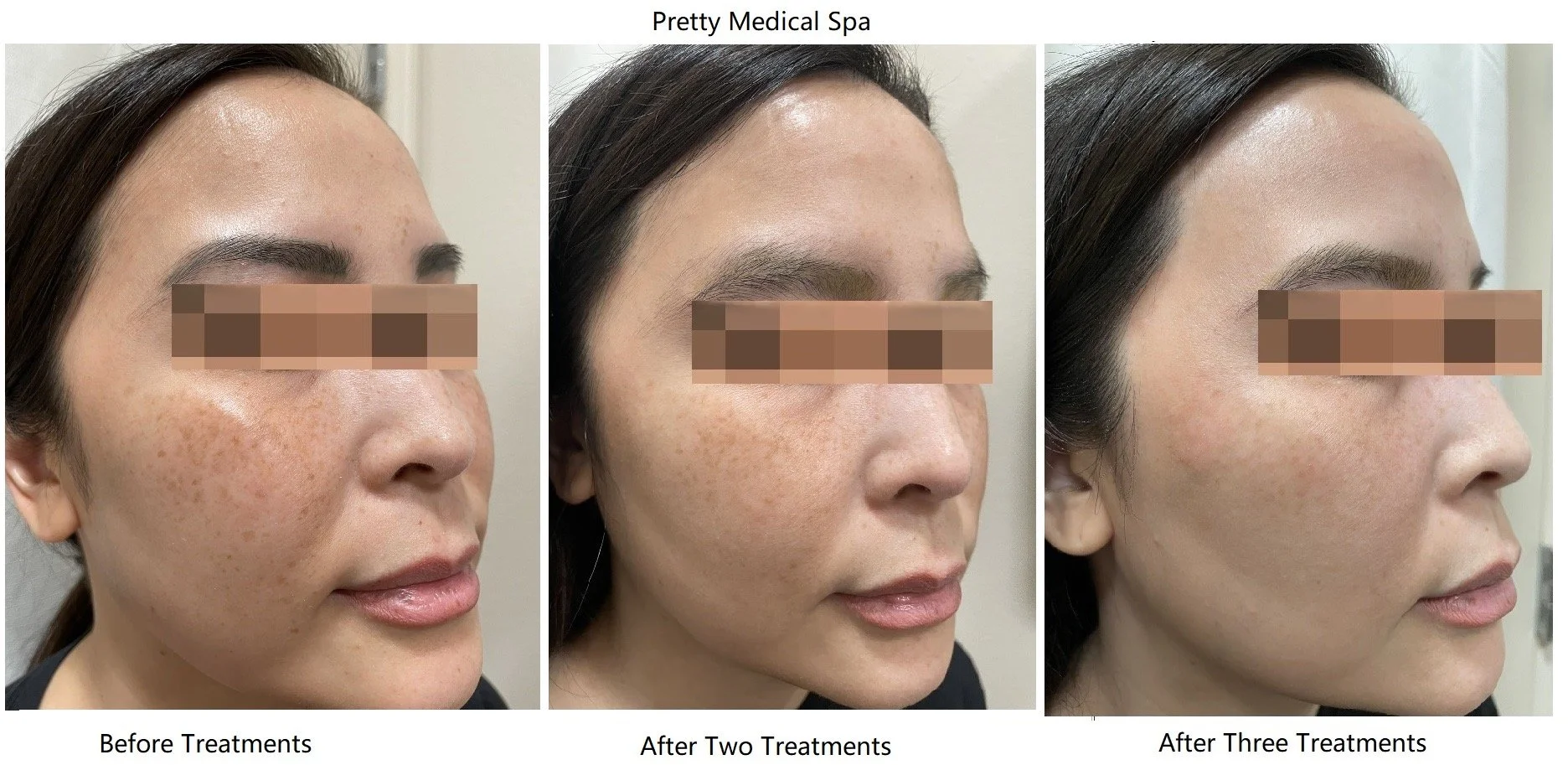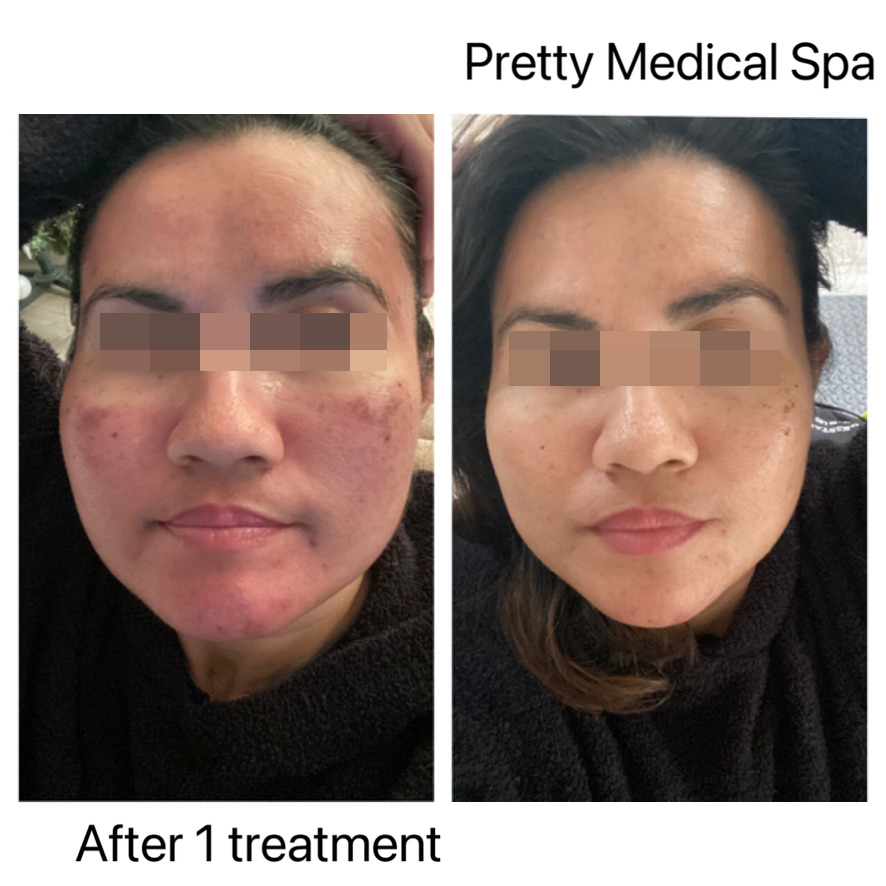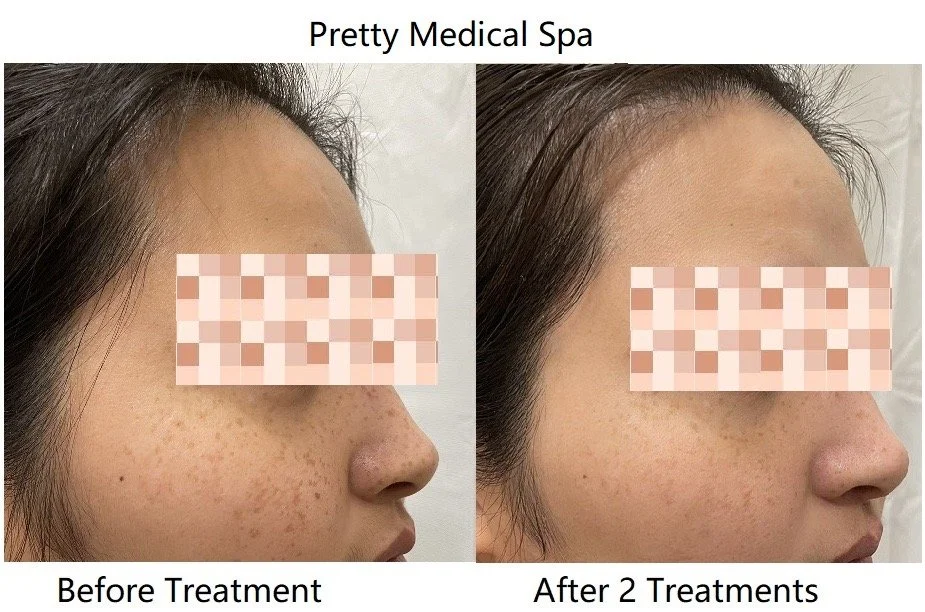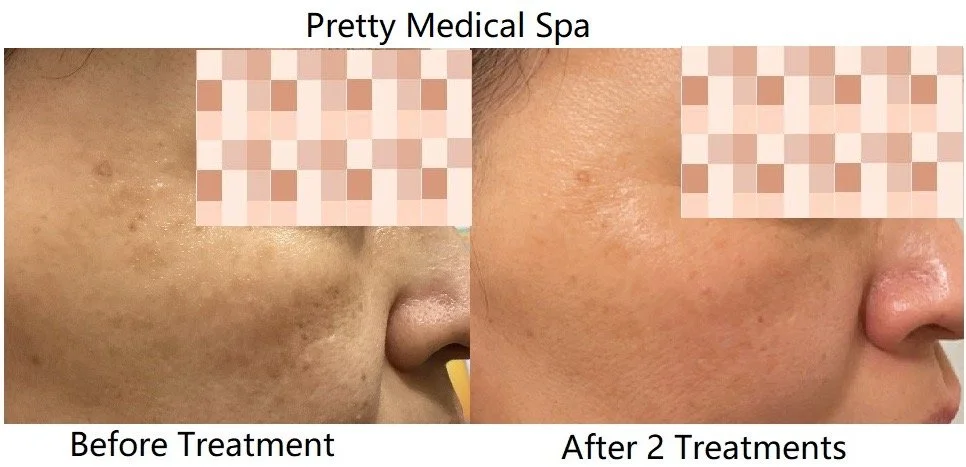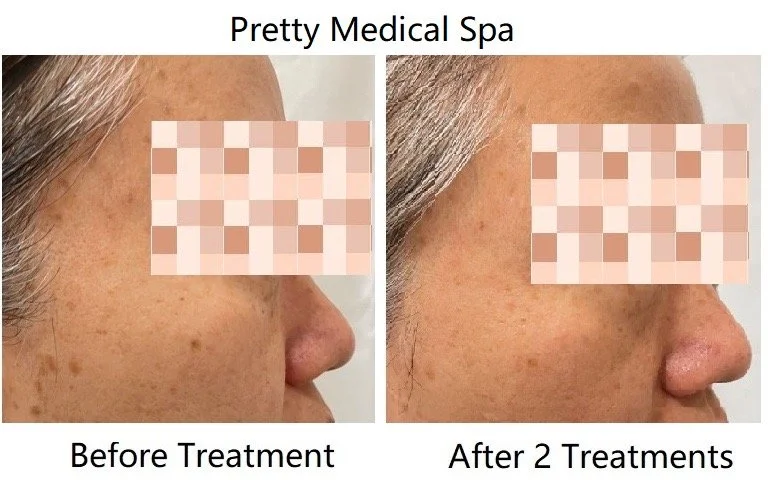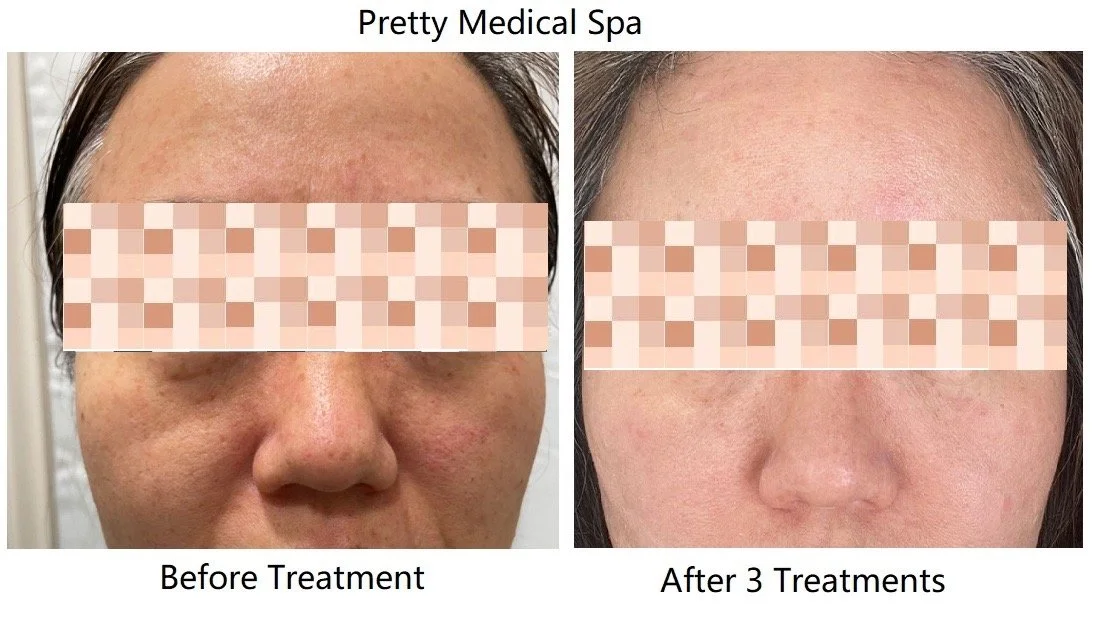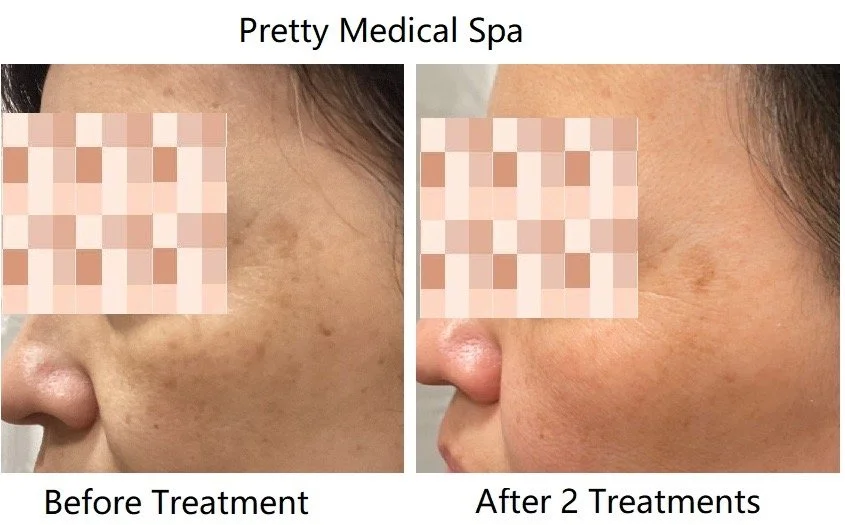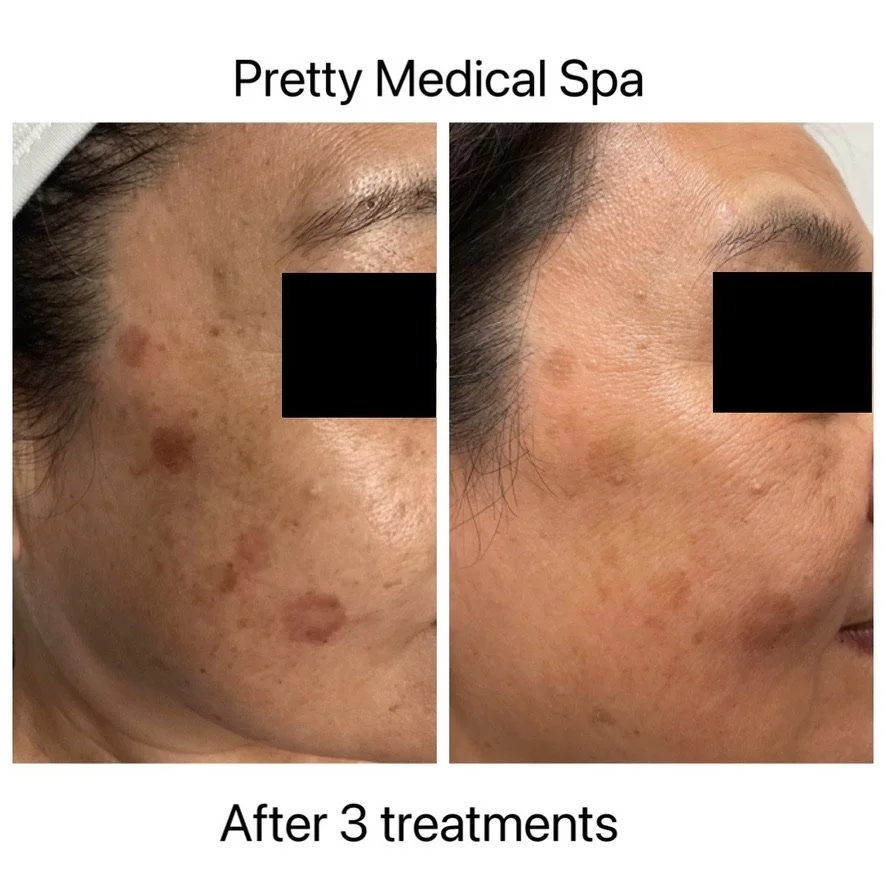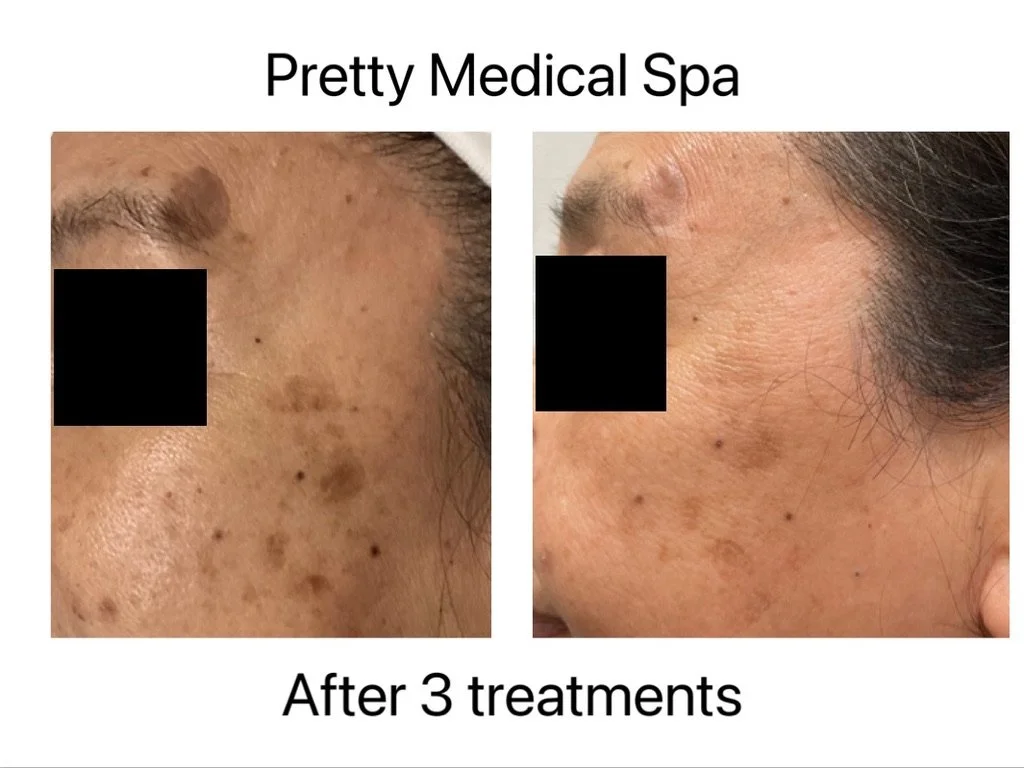
PICOSURE Pro
Laser Treatments
PICOSURE Pro laser treatments by Cynosure:
A cutting-edge treatment that uses picosecond laser technology to directly treat age spots and pigmentation and rejuvenate the skin.
Scroll down to learn more about our treatments, results, and pricing.
-
A non-invasive procedure
Targets and reduces acne lesions and inflammation
Improves skin texture
Reduces future acne breakouts
Recommended for individuals with more severe and persistant acne that has not responded well to other acne treatments.
FAQ
How Does It Work?
The treatment utilizes two specific wavelengths of light to penetrate the skin:
Blue light lasers: Target and eliminate acne-causing bacteria, primarily Propionibacterium acnes (P. acnes). Help minimize inflammation and acne breakouts.
Red light lasers: Reduce inflammation and promotes skin healing. Help shrink sebaceous glands, which are responsible for producing excess sebum (oil) and contributing to acne formation.
What Should I Expect During the Procedure?
During the laser treatment session, the patient wears protective eyewear, and the laser device is applied to the affected areas of the skin. The treatment is generally well-tolerated, and patients may feel a mild warming sensation on their skin during the procedure.
How Many Sessions Do I Need?
Like many other laser treatments, multiple sessions are often required to achieve significant and lasting results. The exact number of sessions needed can vary depending on the severity of the acne and the individual's response to the treatment.
What Happens After the Treatment?
After the procedure, patients may experience some mild redness or sensitivity in the treated areas. This usually subsides within a few hours to a day. It is essential to follow any post-treatment instructions provided by the healthcare professional, which may include avoiding sun exposure and using sunscreen to protect the treated skin.
Is It For Me?
Laser treatment for acne is most effective for individuals with mild to moderate acne, including papules, pustules, and inflammatory acne.
It may not be as effective for severe cases or for individuals with certain skin types, such as very dark skin, due to the risk of pigment changes.
Can I Combine It With Other Acne Treatments?
In some cases, laser treatment for acne may be combined with other acne therapies, such as topical medications or oral antibiotics, to enhance results and provide a comprehensive approach to managing acne.
It is crucial to consult with a qualified dermatologist or skincare professional before considering laser treatment for acne. They can assess your specific acne concerns, skin type, and medical history to determine if this treatment is suitable for you and design a personalized plan to address your acne effectively.
-
Laser treatment for melasma is a non-invasive procedure used to address the hyperpigmentation and discoloration associated with melasma. Melasma is a common skin condition characterized by dark, irregular patches or spots on the face, typically affecting the cheeks, forehead, upper lip, and chin. It is often triggered or exacerbated by sun exposure and hormonal changes, making it more prevalent in pregnant women (chloasma or "mask of pregnancy") and women using birth control pills.
How it works: Laser treatment for melasma utilizes specific wavelengths of light that target and break down excess melanin (the pigment responsible for skin color) in the affected areas. The laser's energy is absorbed by the melanin, leading to its fragmentation and subsequent dispersal, which can reduce the appearance of dark spots and even out skin tone. Different types of lasers can be used for treating melasma.
Fractional lasers: Fractional lasers create tiny, controlled wounds in the skin, promoting the production of new collagen and resurfacing the skin's top layer. This type of laser is more suitable for treating dermal melasma, which affects the deeper layers of the skin.
Procedure: During the laser treatment session, the patient may wear protective eyewear, and the laser device is applied to the areas of melasma. The treatment is relatively quick, and patients may feel a mild warm or tingling sensation during the procedure.
Multiple sessions: Like many laser treatments, multiple sessions are often necessary to achieve optimal results. The number of sessions required depends on the severity of the melasma and the individual's response to the treatment.
Post-treatment care: After the procedure, patients may experience some redness and mild irritation in the treated areas. Sun protection is crucial after laser treatment for melasma, as sun exposure can trigger melasma recurrence. Patients are usually advised to use sunscreen and avoid prolonged sun exposure.
Suitable candidates: Laser treatment for melasma is typically most effective for individuals with mild to moderate melasma and those who have not responded well to other treatments such as topical creams or chemical peels. However, it may not be as effective for severe cases of melasma or for individuals with darker skin tones, as there is a risk of post-inflammatory hyperpigmentation.
As with any cosmetic procedure, it's essential to consult with a qualified dermatologist or skincare professional before considering laser treatment for melasma. They can assess your specific melasma concerns, skin type, and medical history to determine if this treatment is suitable for you and design a personalized plan to address your melasma effectively.
-
Laser skin rejuvenation is a popular and effective cosmetic procedure designed to address various signs of skin aging and skin damage. It utilizes specific wavelengths of light to target and treat specific skin concerns, promoting collagen production, improving skin texture, and reducing the appearance of wrinkles, fine lines, sunspots, and other skin imperfections.
How it works: Laser skin rejuvenation involves using laser technology to penetrate the skin's deeper layers, targeting specific chromophores (pigments) within the skin, such as melanin or hemoglobin. The energy from the laser stimulates the body's natural healing response, promoting collagen and elastin production, which are essential proteins for maintaining skin's elasticity and youthful appearance. Different types of lasers can be used for skin rejuvenation, depending on the specific skin concerns being addressed.
Fractional lasers: These lasers create microscopic treatment zones in the skin, leaving surrounding areas untouched. Fractional laser treatment promotes skin renewal and collagen production, making it effective for addressing fine lines, wrinkles, and acne scars.
Non-ablative lasers: These lasers do not remove the outer layer of the skin but penetrate deeper to stimulate collagen production. They are ideal for treating pigmentation issues and improving skin texture.
Procedure: During the laser skin rejuvenation procedure, the patient may wear protective eyewear, and the laser device is applied to the targeted areas of the skin. The treatment is usually well-tolerated, and patients may experience a mild warming or snapping sensation during the procedure.
Downtime and recovery: Depending on the type and intensity of the laser used, patients may experience some redness, swelling, or mild peeling after the treatment. Downtime can vary from a few days to a couple of weeks, depending on the aggressiveness of the treatment.
Multiple sessions: While some improvement can be noticed after a single session, multiple sessions are often recommended for optimal and long-lasting results. The number of sessions required will depend on individual skin concerns and treatment goals.
Suitable candidates: Laser skin rejuvenation is generally suitable for individuals with mild to moderate skin aging concerns, such as fine lines, wrinkles, sunspots, and uneven skin tone. It may not be suitable for individuals with certain skin conditions or those with very dark skin tones, as they may have an increased risk of complications.
It's crucial to consult with a qualified dermatologist or skincare professional before considering laser skin rejuvenation. They can assess your specific skin concerns, skin type, and medical history to determine if this treatment is suitable for you and design a personalized plan to achieve your desired skin rejuvenation goals effectively. Additionally, combining laser skin rejuvenation with other treatments, such as topical products or chemical peels, can enhance overall results and address a broader range of skin concerns.
-
PicoSure is a specific brand of laser technology that has gained popularity for its use in treating various skin concerns, including pigmentation issues. PicoSure laser treatment utilizes picosecond laser pulses, which are extremely short bursts of energy that target pigment particles with greater precision and minimal damage to the surrounding skin. This technology is particularly effective for treating pigmentation problems and can be a valuable option for individuals seeking to address skin discoloration.
Here's how PicoSure laser treatment works for pigmentation:
Targeting Pigmentation: PicoSure's ultra-short pulses of laser energy target pigmentation areas in the skin. The energy is absorbed by the pigmented cells, causing them to break down into smaller fragments.
Mechanical Impact: Unlike traditional lasers, PicoSure delivers energy in picoseconds (trillionths of a second), creating a "pressure wave" effect that shatters the pigmented particles into very fine pieces. This is believed to result in more efficient pigment clearance and stimulate the body's natural healing processes.
Body's Natural Processes: After the pigmented cells are fragmented, the body's immune system works to remove these particles naturally. Over time, the broken-down pigments are metabolized and eliminated from the body.
Collagen Stimulation: Along with treating pigmentation issues, PicoSure also has a secondary benefit of stimulating collagen production in the skin. This can contribute to overall skin rejuvenation, helping to improve skin texture and tone.
Minimal Downtime: PicoSure is designed to have minimal downtime compared to some other laser treatments. While you might experience redness and mild swelling immediately after the treatment, these effects typically subside within a few hours to a day.
Multiple Sessions: Just like other laser treatments, multiple sessions are often required to achieve optimal results. The exact number of sessions depends on the severity of pigmentation and individual response to treatment.
PicoSure is often used to treat a range of pigmentation issues, including: Freckles, Sun spots, Age spots, Melasma, Post-inflammatory hyperpigmentation.
As with any medical procedure, it's important to consult with a qualified dermatologist or skincare professional before undergoing PicoSure treatment. They can assess your skin type, pigmentation concern, and overall health to determine if PicoSure is a suitable option for you. While PicoSure is generally considered safe and effective, there might be some temporary side effects like redness, swelling, or mild discomfort after the procedure.
Remember that consistent sun protection and proper skincare are important both before and after laser treatment to maintain the results and prevent new pigmentation issues from developing.
-
Item description
PicoSure is a laser technology that is also widely used for tattoo removal. It's known for its effectiveness in breaking down tattoo pigments with its picosecond pulses of laser energy. Tattoo removal with PicoSure is generally considered faster and more efficient compared to older laser technologies due to its ability to deliver high-energy pulses in extremely short durations.
Here's how PicoSure tattoo removal works:
Targeting Tattoo Pigments: The PicoSure laser emits ultra-short pulses of energy in picoseconds. These pulses target the tattoo ink particles in the skin without causing significant damage to the surrounding tissue.
Fragmentation of Ink: The intense energy from the laser shatters the tattoo ink particles into smaller fragments. These smaller particles are more easily recognized and processed by the body's immune system.
Natural Elimination: Over time, the body's immune system gradually clears away the fragmented tattoo ink particles through the lymphatic system. This is why multiple treatment sessions are needed, typically spaced a few weeks apart.
Colors and Types: PicoSure is effective at treating a wide range of tattoo colors, including stubborn and hard-to-remove ink colors like blue and green. It's suitable for various types of tattoos, including professional, amateur, and even previously treated tattoos.
Minimal Downtime: PicoSure tattoo removal usually involves minimal downtime. Patients might experience redness, swelling, and minor discomfort after the procedure, but these effects are generally temporary.
Number of Sessions: The number of PicoSure tattoo removal sessions required varies based on factors such as tattoo size, ink colors, ink depth, and individual skin response. On average, several sessions are needed to achieve significant fading or complete removal.
It's important to note that while PicoSure offers efficient and advanced tattoo removal, complete removal of a tattoo may not always be achievable, especially if the tattoo contains certain pigments that are more resistant to laser treatment. Additionally, individual responses to treatment can vary.
If you're considering PicoSure tattoo removal, it's essential to consult with a qualified and experienced dermatologist or healthcare provider who specializes in laser tattoo removal. They can evaluate your tattoo, assess your skin type, discuss the expected outcomes, and create a personalized treatment plan based on your goals.
Like any laser treatment, there can be risks and potential side effects, so proper aftercare and sun protection are crucial during the recovery process.
-
Laser hair removal is a popular and effective cosmetic procedure used to reduce or eliminate unwanted body hair. It involves using concentrated beams of light (laser) to target hair follicles, which absorb the light, heat up, and eventually become damaged, inhibiting future hair growth. This treatment can be performed on various areas of the body, including the face, legs, underarms, bikini area, chest, and back.
How it works: During the treatment, a handheld laser device emits a specific wavelength of light that is absorbed by the pigment (melanin) present in the hair follicles. The laser's energy is transformed into heat, which damages the hair follicles, leading to the reduction of hair growth. Since the laser targets the hair follicles' melanin, it is more effective on individuals with darker hair and lighter skin, as the contrast allows for better absorption and less risk of damaging surrounding skin.
Multiple sessions: Laser hair removal is not a one-time treatment, as hair grows in different cycles. To achieve optimal results, multiple sessions are typically required. The exact number of sessions needed varies depending on individual factors such as hair color, skin type, and the targeted area. Usually, 6 to 8 sessions, spaced several weeks apart, are recommended for significant and lasting hair reduction.
Preparing for the procedure: Before undergoing laser hair removal, it's essential to have a consultation with a qualified and experienced medical professional or licensed technician. They will assess your skin type, hair color, medical history, and any contraindications to determine if you are a suitable candidate for the treatment.
Procedure: On the day of the procedure, the targeted area will be cleaned and sometimes shaved to ensure the laser's energy is focused on the hair follicles rather than the surface hair. The technician will adjust the laser settings based on your skin type and hair color. You may be given protective eyewear to shield your eyes from the laser during the treatment.’
Aftercare: After the treatment, you may experience some mild redness and swelling in the treated area, which usually subsides within a few hours. It is essential to follow the aftercare instructions provided by your technician or healthcare professional, which may include avoiding sun exposure, using sunscreen, and refraining from activities that could irritate the treated skin.
Results: Over the course of several sessions, you should notice a significant reduction in hair growth in the treated area. Many individuals experience long-lasting or even permanent hair reduction, though some maintenance sessions may be needed over time to address any regrowth.
Laser hair removal is generally considered safe when performed by trained professionals. However, it's crucial to choose a reputable clinic or medical spa with experienced staff to minimize the risk of complications and achieve the best results. Always consult with a qualified healthcare professional to discuss your specific needs and determine if laser hair removal is suitable for you.
-
Laser treatment for rosacea is a medical procedure used to manage and improve the symptoms associated with rosacea, a chronic skin condition that primarily affects the face. Rosacea is characterized by redness, visible blood vessels (telangiectasia), acne-like bumps, and sometimes a swollen or bulbous nose (rhinophyma).
How it works: Laser treatment for rosacea utilizes specific wavelengths of light that target the blood vessels and redness associated with the condition. The laser's energy is absorbed by the hemoglobin in the blood vessels, causing them to coagulate and shrink. This process helps to reduce redness and the appearance of visible blood vessels. Different types of lasers can be used for treating rosacea.
Pulsed-dye laser (PDL): This type of laser emits a yellow light that is well-absorbed by the blood vessels. PDL is particularly effective in treating facial redness and visible blood vessels associated with rosacea.
Intense pulsed light (IPL): IPL devices emit a broad spectrum of light that can target both redness and pigmentation. IPL can be used to address various aspects of rosacea, including redness and flushing.
Procedure: During the laser treatment session, the patient may wear protective eyewear, and the laser or IPL device is applied to the areas affected by rosacea. The treatment is usually well-tolerated, and patients may experience a mild warm or stinging sensation during the procedure.
Multiple sessions: Like many laser treatments, multiple sessions are often required to achieve optimal results for rosacea. The number of sessions needed varies depending on the severity of the rosacea and the individual's response to the treatment.
Post-treatment care: After the procedure, patients may experience some redness and mild swelling in the treated areas. These side effects typically subside within a few hours to a day. Patients are advised to avoid sun exposure and use sunscreen regularly to protect the treated skin, as sun exposure can exacerbate rosacea symptoms.
Suitable candidates: Laser treatment for rosacea is typically most effective for individuals with visible blood vessels, facial redness, and mild to moderate symptoms. It may not be as effective for severe cases of rosacea or for those with rhinophyma (bulbous nose).
It's crucial to consult with a qualified dermatologist or skincare professional before considering laser treatment for rosacea. They can assess your specific rosacea concerns, skin type, and medical history to determine if this treatment is suitable for you and design a personalized plan to address your rosacea symptoms effectively. Additionally, the treatment may be combined with other therapies, such as topical medications, to provide comprehensive management of rosacea.
-
Laser skin tightening is a non-invasive or minimally invasive cosmetic procedure used to improve skin laxity and tighten loose or sagging skin. It aims to stimulate collagen production and promote tissue remodeling, leading to a firmer, smoother, and more youthful appearance.
How it works: Laser skin tightening utilizes targeted laser energy to heat the collagen fibers in the deeper layers of the skin. This controlled heating stimulates the body's natural collagen production, leading to the tightening of the existing collagen fibers and the growth of new collagen. Collagen is an essential protein that provides structure and support to the skin, contributing to its firmness and elasticity.
We are using non-ablative lasers: These lasers penetrate the skin without removing the outer layer, targeting the dermal layers where collagen is present. They are ideal for mild to moderate skin tightening and have minimal downtime.
Procedure: During the laser skin tightening procedure, the patient may wear protective eyewear, and the laser device is applied to the targeted areas of the skin. The treatment is usually well-tolerated, and patients may experience a mild warming or snapping sensation during the procedure.
Downtime and recovery: Non-ablative laser skin tightening typically has little to no downtime, with mild redness and swelling that usually subsides quickly
Multiple sessions: While some improvement may be noticeable after a single session, multiple sessions are often recommended for optimal and long-lasting results. The number of sessions needed will depend on the degree of skin laxity and the specific laser used.
Suitable candidates: Laser skin tightening is most effective for individuals with mild to moderate skin laxity and those looking for a non-surgical alternative to address sagging skin. It may not be as effective for individuals with severe skin laxity, in which case surgical options like facelifts may be more suitable.
As with any cosmetic procedure, it's crucial to consult with a qualified dermatologist or skincare professional before considering laser skin tightening. They can assess your specific skin concerns, skin type, and medical history to determine if this treatment is suitable for you and design a personalized plan to achieve your desired skin tightening goals effectively. Additionally, combining laser skin tightening with other treatments or procedures, such as dermal fillers, can enhance overall results and address a broader range of aesthetic concerns.



